 |
[ Outlaw Genealogy | Bruce
History | Lost Chords ] [ Projects | News | FAQ | Suggestions | Search | HotLinks | Resources | Ufo ] |
 |
[ Outlaw Genealogy | Bruce
History | Lost Chords ] [ Projects | News | FAQ | Suggestions | Search | HotLinks | Resources | Ufo ] |
Interesting let's look at the history of the Danish invasion of England timeline .... When did the Utlag's come to England?
450AD - Kingdom of East Anglia - was settled by the Anglo-Saxons as early as around 450, earlier than many other regions. It emerged from the settlement and political consolidation of Angles in the approximate area of the former territory of the Iceni ... According to Bede, the East Angles (as well as the Middle Angles, the Mercians and the Northumbrians) were descended from natives of Angeln ... the first reference to the East Angles is from around 704–713, in the Whitby Life of St Gregory ... The East Angles were initially ruled by the pagan Wuffingas dynasty, apparently named after an early king, Wuffa, although his name could have been an invention to explain the dynastic name, which means 'descendants of the wolf'
500-600AD - Wehha of East Anglia - Wehha was a pagan king of the East Angles who, if he actually existed, ruled the kingdom of East Anglia during the 6th century, at the time the kingdom was being established by migrants from the Jutland peninsula. Early sources identify him as a member of the Wuffingas dynasty, which became established around the east coast of Suffolk. Nothing of his reign is known. - Wehha is thought to have been one of the earliest rulers of East Anglia, an independent and long-lived Anglo-Saxon kingdom that was established in the 6th century, and which includes the modern English counties of Norfolk and Suffolk. ... Rainbird Clarke identified Wehha, the founder of the dynasty, as one of the leaders of the new arrivals: the East Angles are tentatively identified with the Geats of the Old English poem Beowulf.
600-749AD - Wuffa of East Anglia - By tradition Wuffa was named as the son of Wehha and the father of Tytila, but it is not known with any certainty that Wuffa was an actual historical figure. The name Wuffa was the eponym for the Wuffingas dynasty, the ruling royal family of the East Angles until 749. ... It has been suggested that Wuffa and his dynasty may possibly have originated from a Germanic tribe known as the Warni: Wuffa has been identified with the 'King of the Angli', as depicted by the Byzantine scholar Procopius.
616AD - Tytila of East Anglia - (died around 616) was a semi-historical pagan king of East Anglia, a small Anglo-Saxon kingdom which today includes the English counties of Norfolk and Suffolk. ... Tytila was succeeded by his son Rædwald in about 616.
700~1000AD - Útlagi
placed this stone in memory of Sveinn -Rune sm103 - Småland,
Sweden
866AD - Jorvik and the Danes 866AD-900AD
- A Danish army of around 10,000 men invades East Anglia where it encamps for the whole winter. The Danes are led by Ivar the Boneless (so called because of his lanky, gangling appearance) along with his brothers, Halfdene and Hubba.
878AD - Danelaw - ALFRED DEFEATS THE DANES (England)
Alfred the Great of Wessex defeats a Danish army under the leadership of Guthred.
879AD - Kingdom of East Anglia - the Vikings defeated the East Anglians in battle and their king, Edmund of East Anglia, was killed. After 879, the Vikings settled permanently in East Anglia
The Danelaw roughly comprises 15 shires: Yorkshire, Five Boroughs of Leicester, Nottingham, Derby, Stamford and Lincoln, as well as Essex, the Kingdom of East Anglia shires of Cambridgeshire, Suffolk and Norfolk, East Midlands shires of Northamptonshire, Huntingdonshire, Bedfordshire, Hertfordshire, Middlesex and Buckinghamshire; one third of the total area of the English kingdom at the time ... This peace lasted until 884, when Guthrum again attacked Wessex. Alfred defeated him, with peace codified in the Treaty of Alfred and Guthrum
910AD - Danelaw - Edward the Elder and his sister, Æthelflæd, the Lady of the Mercians, conquered Danish territories in the Midlands and East Anglia in a series of campaigns in the 910s, and some Danish jarls who submitted were allowed to keep their lands
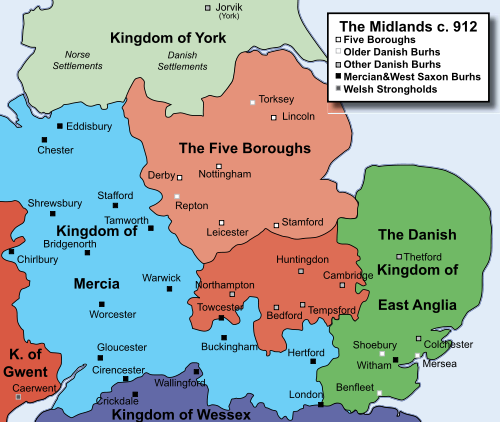
Outlaw 1613
Visitation Legend :
957 - Outlawe(s)
Banished for political offences to Ireland by King
Edwy - St. Dunstan Banished - 1613
Visitation Legend
958 - Outlawe(s) kill - "gather" many Wolves
heads in Ireland - 1613
Visitation Legend
959 - Edgar King of Mercia
and Northumbria becomes King of all England
959 - Outlawe(s) Return to England "with many wolves
heads" under King
Edgar reigns - St. Dunstan returns - 1613
Visitation Legend
960 - King
Edgar general pardon in return for a certain number of wolves' tongues
from each criminal - fact
968-1016AD - Ethelred II (king of England) - (born 968?—died April 23, 1016, London, England), king of the English from 978 to 1013 and from 1014 to 1016. He was an ineffectual ruler who failed to prevent the Danes from overrunning England. ... Danish invasions resumed in 980.
Nearly all of the country was ravaged, and Ethelred’s efforts to buy peace only made the invaders more rapacious. When they did begin to settle down in towns, Ethelred provoked further invasions by launching a massacre of Danish settlers (Nov. 13, 1002). By the end of 1013 the Danish king Sweyn I had been accepted as king in England, and Ethelred had fled to Normandy.
990~1010AD - Utlage raised this stone in memory of Öjvind, a very good thegn - Rune vg62 - Ballstorp, Västergötland, Sweden
991AD - Danegeld - English payment, of 10,000 Roman pounds (3,300 kg) of silver, was first made in 991 following the Viking victory at the Battle of Maldon in Essex, when King Aethelred "The Unready" was advised by Archbishop Sigeric of Canterbury and the aldermen of the south-western provinces to buy off the Vikings rather than continue the armed struggle.
994AD - Danegeld - Danes, under King Sweyn Forkbeard and Olav Tryggvason, returned and laid siege to London. They were once more bought off, and the amount of silver paid impressed the Danes with the idea that it was more profitable to extort payments from the English than to take whatever booty they could plunder.
1002 - Danegeld
1002 - St. Brice's Day massacre
- was the killing of Danes
in the Kingdom
of England on 13 November 1002, ordered by King Æthelred
the Unready. In 1002 the king was told that the Danish men in England
"would faithlessly take his life, and then all his councillors, and possess
his kingdom afterwards." In response, he "ordered slain all the Danish
men who were in England."
1007 - Danegeld - Aethelred bought two years peace with the Danes for 36,000 troy pounds (13,400 kg) of silver
1012 - Danegeld - 1012, following the capture and murder of the Archbishop of Canterbury, and the sack of Canterbury, the Danes were bought off with another 48,000 troy pounds (17,900 kg) of silver.
1012 - Thorkell and his loyalists defected and he and his men entered into the service of king Ethelred the Unready, whom they fought under in 1013 against the invasion of king Sweyn Forkbeard and his son Cnut
1016-1035 - Danelaw
-- From 1016 to 1035 Cnut
the Great ruled over a unified English kingdom
1016 - Danegeld - Sweyn
Forkbeard's son, Canute,
became King of England. After two years he felt sufficiently in control of
his new kingdom to the extent of being able to pay off all but 40 ships of his
invasion fleet, which were retained as a personal bodyguard, with a huge
Danegeld of 72,000 troy pounds (26,900 kg) of silver collected nationally,
plus a further 10,500 pounds (3,900 kg) of silver collected from London.
1017 - Thorkell the Tall
- he was proclaimed to be the Jarl
of East
Anglia, in 1017, after the coronation of the Viking king of England.
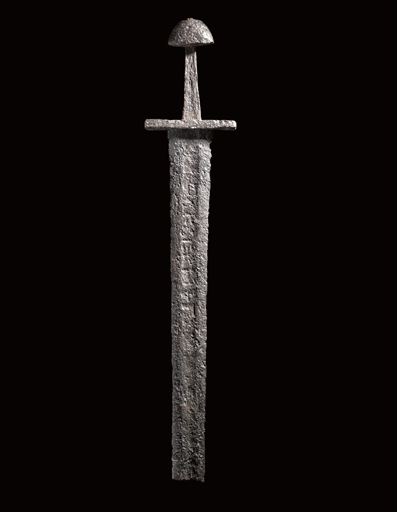 A VERY RARE VIKING SWORD, THE BLADE WITH
ULFBERHT INSCRIPTION
A VERY RARE VIKING SWORD, THE BLADE WITH
ULFBERHT INSCRIPTION
CIRCA 950
In excavated condition (the upper half of the blade missing), the blade of late
pattern-welded construction with a wide shallow central fuller, one side cut
with the inscription 'Vlfberh+t' in characteristically large capitals
originally inlaid in contrasting iron, the reverse with traces of a further
inscription, fitted with robust guard of rectangular section, and one-piece
pommel of so-called 'tea-cosey' type.
18 1/8in (46cm) blade
[ Interesting Berht = White bright and Ulf - so these were "Bright Wolf" swords... ]
Secrets of the Viking Sword (2012) full - YouTube
The Vlfberht sword blades reevaluated - ANNE STALSBERG
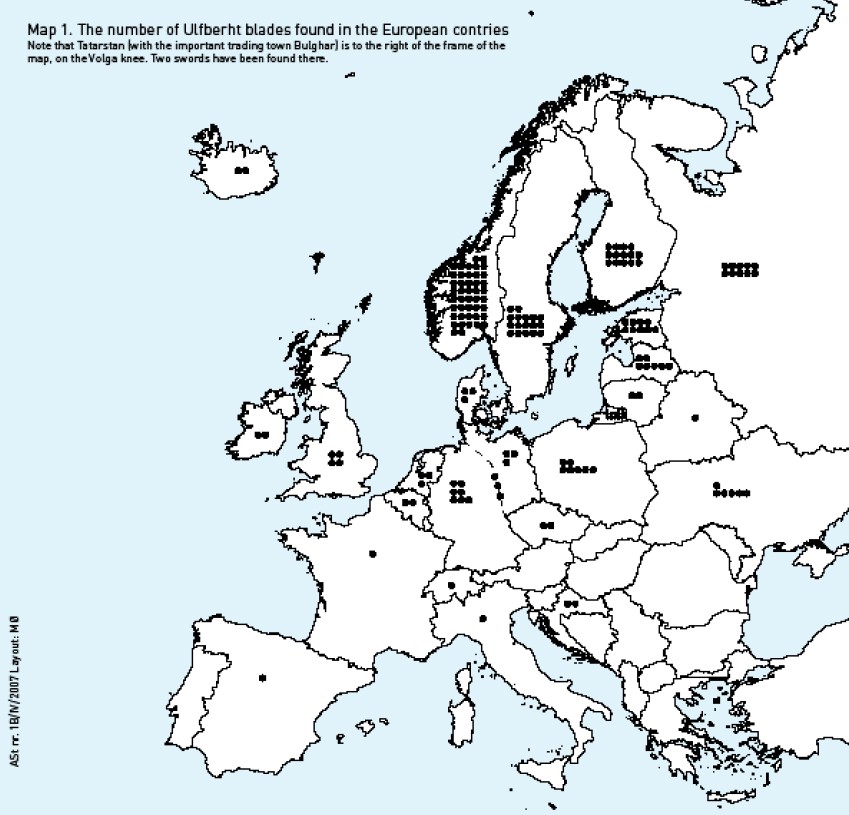
http://greaterancestors.com/very-strong-men-from-england/
...
Rephaim23 on December 24, 2011 at 7:05 am said:
In the year 1994 the bones of a giant man 7 feet tall, and a woman over 6
feet tall were found near Thirsk Castle, England. Evidently a population of
“Saxon giants” once lived in the area:
http://www.thirskmuseum.org/giant.htm
http://yorkshire.greatbritishlife.co.uk/article/thirsk-enter-a-land-of-giants-and-curses-and-re-discover-this-north-yorkshire-market-town-22860/
“Archaeologist Demands Respect for Giants’ Bones
Bones pointing to the existence of a community of “Saxon giants” in
north Yorkshire go on display next month despite a protest from the
archaeologist who found them.
The part-skeletons are an extraordinary find. Dug up from a
sixth-century Saxon cemetery discovered beneath the ruins of Thirsk Castle,
they indicate a seven-foot-tall man and a woman more than six feet in height.
A number of children were also buried there.
“These bones could explain why there are quite a number of hefty Yorkshiremen
about,” said Cooper Harding, curator at Thirsk Museum, where the remains will
be displayed.
“You can imagine the terror of the native Celtic farmers, who were quite
short, when confronted by these giants.”
But Leslie Webster, a curator at the British Museum, specialising in the early
Anglo-Saxon period, said last night: “Saxons were not particularly tall.
These bones are certainly not normal. It would not be a normal height for any
period of British history.”
The cemetery was discovered by archaeologist Anne Finney five years ago by pure
chance during a routine dig among the castle ramparts. But the artefacts have
been kept hidden from the public, stored in vaults and seen only by academics.
Ms Finney, who runs a firm called Map Archaeological Consultancy, handed them
over to the Yorkshire Archaeological Trust.
Thirsk Museum lobbied intensely for the bones and items of jewellery –
including a stunning bronze cruciform brooch and early Saxon pottery – to be
handed over and put on public display. It finally won after a five-year battle.
But Ms Finney is unhappy with the museum’s plans. “It was a very good find.
But the bones should not be on display. You should treat human remains with
reverence.”
Mr Harding said: “Our display will be restrained and thoughtful. But as you
can see, it is the bones which capture the interest of the public.”
[Source: The Independent / London / By Robert Mendick - March 12 2000 ]
\ - - - - -
http://www.thirskmuseum.org/giant.htm

The foot (above) and parts of a skull (below) were recovered during
excavations of a Saxon burial ground at Castle Garth, near the Museum.
Measurements of the leg bones show that the person stood nearly seven feet
tall. Thirsk’s “Saxon Giant” can be seen in the Reynolds Room on the
first floor of the Museum.
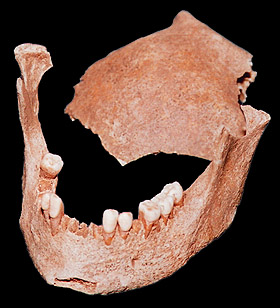
http://www.thirskpastandpresent.co.uk/bd1-3.htm
...
In the summer of 1994 an archaeological excavation took place on this part of
the site in connection with the installation of a sub-station by Northern
Electric. The dig revealed a hitherto undetected sixth-century burial site.
This discovery confirmed the belief that Thirsk existed as a settlement long
before the arrival of the Normans in the late 11th century.
When the Roman Legions were withdrawn from northern Britain in AD 402 there were
already people from the north-western part of Europe settled here as part of the
Roman army and as time went by they were joined by more immigrants from across
the North Sea.
The folk settling in Yorkshire were Angles rather than Saxons and by AD
560 an Anglian chieftain called Aella ruled over a north-eastern kingdom called
Deira.
The graves found here belong to the first half of the sixth century and the
artifacts associated with them are in a typically Anglian style.
The archaeologists found that graves had been disturbed at a later date,
probably when the castle ditch was dug, but had not been robbed. From the
size of the bones found in one of the graves we know that the man buried there
stood about seven feet - well over two metres - tall. Were there giants in those
days?
Full details of the 1994 dig and the finds from the site can be found at Thirsk
Museum in Kirkgate.
http://en.wikipedia.org/wiki/Deira
Deira (Old English: Derenrice or Dere) was a kingdom in Northern England which
probably emerged when Anglian warriors conquered the Derwent Valley in
the third quarter of the fifth century.[1] It extended from the Humber to the
Tees, and from the sea to the western edge of the Vale of York. It was the
southern of the two kingdoms of Deira and Bernicia which later merged to form
the kingdom of Northumbria.
...
The first Anglian king of Deira of whom we have any record is Ælla, who
flourished in the later 6th century after conquering the realm from the Britons
in 581
http://www.historyfiles.co.uk/KingListsEurope/ScandinaviaAngeln.htm
...
A list of the kings of Angeln has been preserved in the Old English epic poems,
Beowulf (telling the story of a prince of the Geats) and Widsith, both of
which probably provided source material for the Anglo-Saxon Chronicle. Some
names were added in the seventh to ninth centuries by chroniclers trying to make
sense of the oral traditions they were writing down. They seem to have been
famous figures in their own right, existing in pre-migration Frisia and Denmark.
...
Woden is claimed as an ancestor figure by many of the Anglian, Jutish and
Saxon tribes which later migrate to Britain. Is it possible that this
semi-mythical figure represents a powerful Anglian king whose many sons and
their descendants find or create positions of power as the Anglian peoples
fragment before and during their migration? Those claiming him as an ancestor
include the descendants of Baeldaeg, Benoc, Caser, Waegdaeg and Wehta, while the
kings of Lindsey claim direct descent from him.
http://www.historyfiles.co.uk/KingListsEurope/ScandinaviaMinorPrinces.htm
Minor Anglian, Jutish & Saxon Princes
Woden, legendary king of Angeln, is claimed as an ancestor figure by many of
the Anglian, Jutish and Saxon tribes which migrated to Britain. Although
entirely impossible to prove, one theory is that this semi-mythical figure
represents a powerful Anglian king whose many sons and their descendants found
or created positions of power as the Anglian peoples fragmented before and
during their migration.
...
Waegdaeg's Folk
One of the sons of Woden, king of Angeln,
Wægdæg was the originator of the line of princes which migrated to Britain
in the fourth to fifth centuries and created the Anglian kingdom of Deira based
on an existing British territory known as Deywr.
Wægdæg / Waegdaeg
Son of Woden of Angeln. Originator of the Deiran Angles.
Sigegar Son.
Swebdaeg Son.
Sigegeat Son.
c.420
Sæbald / Saebald Son. Led the Angles as laeti into Deywr?
c.420
Saebald apparently leads his people into Deywr in Britain to settle as
laeti. In 559, his descendant founds the independent Anglian kingdom of Deira.
|- - - - - -
Caser's Folk
One of the sons of Woden, king of Angeln, Caser was the originator of the line of princes which migrated to Britain in the late fifth and early sixth centuries and founded the Anglian kingdom of the East
Angles.
Caser Son of Woden of Angeln. Originator of the East Angles.
Tyttman Son.
Trygil Son.
c.490s
Wealhtheow is the queen of the Danes, wife of Hrothgar. Her husband appears in Norse Sagas and two Old English epic poems, Beowulf and
Widsith, while she is a Wulfing, ancestor (or mother) of the Wuffingas who, within twenty years, are to be found creating their own kingdom of the East Angles in Britain.
Hrothmund Son.
c.510s
Hrype Son. Probably in Britain.
c.530s
Wilhelm Son. Probably in Britain.
c.560s
Wehha Son. Possibly sowed the seeds of East Anglian consolidation.
571 - 578
Wuffa Son. United North and South Folk to form the East Angles.
571
Wuffa is the first acknowledged king of the East Angles, a kingdom that is founded more than a century after the first coming of the Anglo-Saxon peoples to Britain.
| - - - - - -
Teutonic mythology, Volume 4 By Jacob Grimm
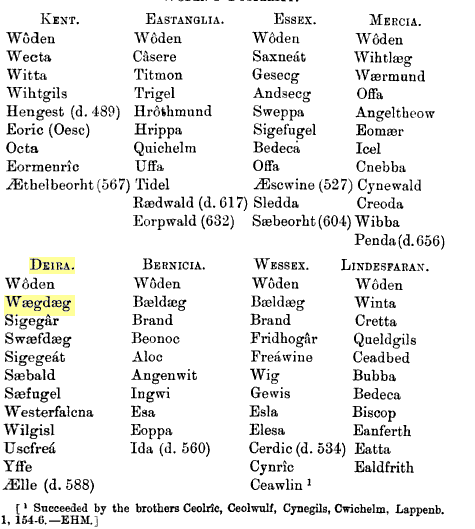
1674 - Thomas Outlaw - County Norfolk - Admitted Corpus Christi College - Cambridge
The history of the College of Corpus Christi and the B. Virgin Mary
Royal Navy casualties, killed and died, June 1940 - Evacuation of Dunkirk ends, Italy at war, Action at sea in the Mediterranean, France falls
1940 - Argyllshire, ship loss - OUTLAW, Samuel J, Engineman, RNSR, LT/KX 100326, killed
1969 - SP4 Charles Reuben Outlaw, Jr, West Palm Beach, FL - KIA - Vietnam
SP4 Charles Reuben Outlaw, Jr, West Palm Beach, FL
Specialist Four
A BTRY, 1ST BN, 8TH ARTILLERY, 25TH INF DIV, USARV
Army of the United States
West Palm Beach, Florida
June 24, 1949 to March 04, 1969
| CASUALTY DATA: | |
| Start Tour: | 08/13/1968 |
| Incident Date: | 03/04/1969 |
| Casualty Date: | 03/04/1969 |
| Age at Loss: | 19 |
| Location: | Hau Nghia Province, South Vietnam |
| Remains: | Body recovered |
| Casualty Type: | Hostile, died outright |
| Casualty Reason: | Ground casualty |
| Casualty Detail: | Gun or small arms fire |
| - - - -
CHARLES REUBEN OUTLAW JR
- CHARLES REUBEN OUTLAW JR is honored on Panel 30W, Row 38 of
the Vietnam Veterans Memorial.

Interesting found Outlaw families in Cambridge Stretham and Swaffham Prior -
Was Trying to find more records of William Outlaw of 1614 from Emmanuelle College Cambridge
The History of the County of Cambridge, from the Earliest Account ... - Edmund Carter
1643 - William Outlaw - Freeholder St. Mary's Swaffham Prior Cambridge
Swaffham Prior - is a village in East Cambridgeshire, England.
The village is dominated by its twin churches that have served the parish since at least the 12th century – the Church of St Mary, and the Church of St Cyriac and St Julitta (dedicated to Saint Quiricus and Saint Julietta). In 1667 a parliamentary order combined the churches under a single parish.
The church of St Mary was first built in Norman times, and over its history has at times been allowed to fall into ruin, only being fully restored at the start of the 20th century and now serving as the parish church. It contains an attractive rood screen, and is celebrated for its series of stained glass windows showing scenes from World War I.
The original church of St Cyriac and St Julitta (Cyriac's mother) was built prior to 1200, and may possibly have existed before 1066. The present chapel is a plain Gothic-style church, consisting of a small chancel and nave with three small transeptal chapels. The tower was built in the 15th century tower and contains 6 bells. Having fallen into disuse, in 1878 an order was received that the church be demolished, but the order was never carried out. It now serves as a hall for exhibitions and other functions. Scottish poet Edwin Muir (1887-1959) is buried here.
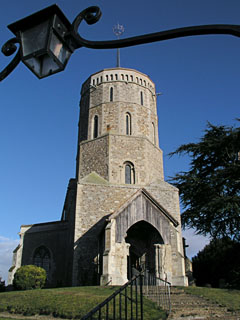 Cambridgeshire
Churches - Swaffham Prior, Saint Mary the Virgin - Swaffham Prior is
famous amongst Cambridgeshire villages for having two churches in the same
churchyard. The effect is quite dramatic: a grass slope punctuated with cedar
trees rises steeply away from the main street, and crowning it sit the two
churches of St Mary the Virgin and SS Cyriac and Julitta. ... The two
churches served completely separate parishes, despite the fact that the
population of Swaffham Prior was never more than a couple of hundred people.
Cambridgeshire
Churches - Swaffham Prior, Saint Mary the Virgin - Swaffham Prior is
famous amongst Cambridgeshire villages for having two churches in the same
churchyard. The effect is quite dramatic: a grass slope punctuated with cedar
trees rises steeply away from the main street, and crowning it sit the two
churches of St Mary the Virgin and SS Cyriac and Julitta. ... The two
churches served completely separate parishes, despite the fact that the
population of Swaffham Prior was never more than a couple of hundred people.
John Outlaw - page 1 - Parish Baptism Search - Genes Reunited
Outlaw John 1625 Swaffham Prior, St Cyriac Cambridgeshire
Outlaw John 1654 Swaffham Prior, St Cyriac Cambridgeshire
Outlaw John 1656 Swaffham Prior, St Cyriac Cambridgeshire
Outlaw John 1664 Stretham Cambridgeshire
Outlaw John 1666 Stretham Cambridgeshire
Outlaw John 1679 Swaffham Prior, St Mary Cambridgeshire
Outlaw John 1686 Swaffham Prior, St Mary Cambridgeshire
Outlaw John 1692 Swaffham Prior, St Mary Cambridgeshire
Outlaw John 1695 Swaffham Prior, St Mary Cambridgeshire
Outlaw John 1697 Swaffham Prior, St Mary Cambridgeshire
Outlaw John 1703 Swaffham Prior, St Mary Cambridgeshire
Outlaw John 1706 Swaffham Prior, St Mary Cambridgeshire
NOTES ON THE BISHOPS' TRANSCRIPTS (continued).
In making the following notes and extracts, the object kept in view has been to give an idea of the years for which the Transcripts are to be found, and (except of course in the towns) of the principal families to be found in each
parish; as well as extracts relating to the families whose pedigrees are given in the Heralds' Visitations, and all entries which appeared to be in any way remarkable or to relate to persons unconnected with the parishes where the entries occur, and which might therefore otherwise be looked for in vain. Considerable care has also been taken to note the Clergy who sign or are otherwise mentioned in the Transcripts, so as to supply to some extent the place of the lost Institution Registers.
The names given in italics and in brackets are those which appear constantly in the respective registers. It need scarcely be added that the examination of so many transcripts was necessarily a somewhat cursory one, but it has been made as exhaustive as the circumstances would allow.
From 1599 to 1700 is the period as a rule covered by these notes.
Outlaw Cambridge Parishes : Stretham - Shepreth - Dullingham - Wilburton
1951 - GEORGE M OUTLAW SFC - Bertie County , NC - KIA - APRIL 18, 1951
Korean War Casualty Lists - MIA KIA WIA POW - Korean War Project
SFC GEORGE M OUTLAW
65TH INFANTRY REGIMENT
HVY TNK CO
3RD INFANTRY DIVISION
ARMY
HOSTILE, DIED (KIA)
DATE OF LOSS: APRIL 18, 1951
SERVICE NUMBER: RA34308338
YEAR OF BIRTH: 1918
HOME OR PLACE OF ENLISTMENT
BERTIE COUNTY, NC
Comments: Sergeant First Class Outlaw was a member of the 65th Infantry Regiment, 3rd Infantry Division. He was Killed in Action while fighting the enemy in South Korea on April 18, 1951.
KOREAN WAR PROJECT KEY NO: 22549
Thus is interesting since Chisell or Chrishall is an important place.... Eustace of Boulogne was in charge of the crusades and when they get Jerusalem he makes his younger brother King there. Matilda marries Stephen (King of England 1135) and supports the Templar . Notice the connection to "the Holy Trinity" What is interesting is Joan Outelagh as Widow retains the land of her husband in these documents - 8 hides and 120 acres was a bit of land:
1 carucate of land is about 120 acres of land or what eight oxens could plow in a season "8 hides",
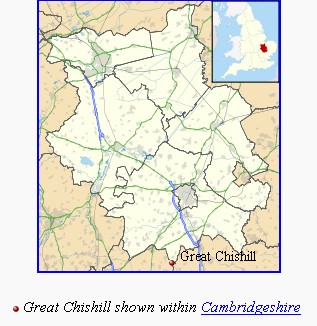 Great Chishill
- The highest point of Essex,
Chrishall
Common and the triple
point of Cambridgeshire, Essex and Hertfordshire
lie close to each other and about 2 kilometres (1 mi) south of Great
Chishill.... St. Swithun’s Church, situated on high ground at the
crossroads was founded in 1136 by Geffrey de Magnaville under the Monastery of (Saffron)
Walden....Little Chishill has the Church of St. Nicholas,
probably founded around the same time, its first recorded vicar was John Martyn
in 1333.... Until 1895, Chishill was in Essex but then the boundary was changed
and it became Cambridgeshire.
Great Chishill
- The highest point of Essex,
Chrishall
Common and the triple
point of Cambridgeshire, Essex and Hertfordshire
lie close to each other and about 2 kilometres (1 mi) south of Great
Chishill.... St. Swithun’s Church, situated on high ground at the
crossroads was founded in 1136 by Geffrey de Magnaville under the Monastery of (Saffron)
Walden....Little Chishill has the Church of St. Nicholas,
probably founded around the same time, its first recorded vicar was John Martyn
in 1333.... Until 1895, Chishill was in Essex but then the boundary was changed
and it became Cambridgeshire.
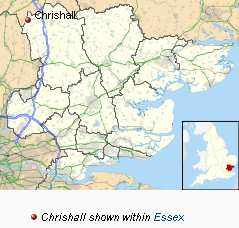 Chrishall
- The Icknield
Way, a Neolithic track, passes through the parish
Chrishall
- The Icknield
Way, a Neolithic track, passes through the parish
Following the Norman Conquest the area around Chrishall was given to Eustace of Boulogne who built and occupied a house on a hill to the south of the current church. He named the house "Flanders" and it was there that his daughter Matilda of Boulogne, later wife of King Stephen was raised. A letter survives that the queen wrote to Hubert the Chamberlain ordering that the residents of Chrishall be looked after. The house survived until the 15th century, and is believed to have stood on the site of Chiswick Hall
Matilda of Boulogne
- In 1125, Matilda married Stephen
of Blois, Count of Mortain, who possessed a large honour
in England.
...
Matilda was a supporter of the Knights Templar. She founded Cressing
Temple in 1137 and Temple
Cowley in 1139.[2]
Like her predecessor, Matilda
of Scotland, she had a close relationship with the Holy
Trinity Priory at Aldgate. She took the prior as her confessor and two
of her children were buried ... Matilda died of a fever at Hedingham
Castle, Essex,
England, and is buried at Faversham
Abbey, which was founded by her and her husband
| - - - - -
1360 - John
Outelagh and Joan his wife,
def. 1 messuage and 1 carucate of land in GreatChisell, Little Chisell,
Heyden and Crishale - Essex - Crishall
- Cristeshalla, or "nook of land dedicated to Christ". -
William
atte Wode of Crishale
and Walter Pytee of Chisell, pi. John Outelagh and Joan his wife,
def. 1 messuage and 1 carucate of land in Great Chisell, Little Chisell,
Heyden and Crishale. PI. and the heirs of William to hold of the chief
lords. Cons 100 marks. - 34 EDWARD III
1376 - Widow of John Outelagh , Joan his wife, def. 1 messuage and 1 carucate of land in GreatChisell, Little Chisell, Heyden and Crishale - Essex - John Rydere, parson of Heyden. and Nicholas son of Hugh Parys of Heyden, pi. by John Heyden. William Manewod of Heyden and Alice his wife, def. 2 messuages, 2 tofts, 76 acres of land, 3 acres of wood and 2s. rent in Heyden, Cristeshale, Elmedon and Great Chyshull. PI. and the heirs of Nicholas to hold a moiety of the chief lords, with the homages and services of John Upstret, Katharine Arneys, Richard Curteys and Joan Outlawe and their heirs, and also the remainder of the other moiety, which John atte More of Heyden holds for life by the law of England. Cons. 20 marks. - 49 Edward III
We don't know much about Sir Roger Outlawe Of St. John of Jerusalem Hospitaler's , but I found a description of those they let into the Order. What is interesting was the requirement for them to be of NOBLE BIRTH for FOUR GENERATIONS !
Interesting is this book on Clerkenwell the seat of the order in England:
History and description of the parish of Clerkenwell - Thomas Cromwell
Page 52: (Jerusalem Cross worn by Order of St. John )
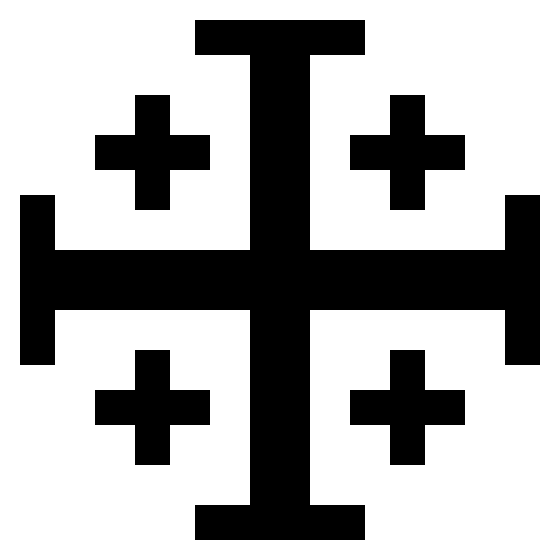 Baldwin,
successor to Godfrey on the throne of Jerusalem,
gave all possible encouragement to our "religious-military" order:
and it is said to have been in his reign, (A. D. 1104) that the brothers
first assumed their peculiar habit, namely, a black robe, having upon the left
side a white cross with eight points, in form of that
still called the Jerusalem Cross. The
religious profession they followed was that of St.
Augustine: and now, their institution having been confirmed by the Patriarch of
Jerusalem, and by Pope Honorius II., "the brethren of
this Order" (says Newcourt), "gave themselves to prayer,
watching, and fasting, and other good works abundantly; and because God was with
them, all men loved them : whereupon it came that their fame went over all the
world, and their form of sanctity over all
coasts; and by the bounty of princes, and alms of
faithful people, they became in a little time so rich, that gathering
from the western provinces plentiful revenues, getting houses and towns, as
princes of the earth they subjected them to their
jurisdiction." In fine, so early as the year 1113, they were in the full
tide of prosperity.
Baldwin,
successor to Godfrey on the throne of Jerusalem,
gave all possible encouragement to our "religious-military" order:
and it is said to have been in his reign, (A. D. 1104) that the brothers
first assumed their peculiar habit, namely, a black robe, having upon the left
side a white cross with eight points, in form of that
still called the Jerusalem Cross. The
religious profession they followed was that of St.
Augustine: and now, their institution having been confirmed by the Patriarch of
Jerusalem, and by Pope Honorius II., "the brethren of
this Order" (says Newcourt), "gave themselves to prayer,
watching, and fasting, and other good works abundantly; and because God was with
them, all men loved them : whereupon it came that their fame went over all the
world, and their form of sanctity over all
coasts; and by the bounty of princes, and alms of
faithful people, they became in a little time so rich, that gathering
from the western provinces plentiful revenues, getting houses and towns, as
princes of the earth they subjected them to their
jurisdiction." In fine, so early as the year 1113, they were in the full
tide of prosperity.
...
The Brethren had vowed themselves to poverty— and they were now overflowing with wealth; to obedience—and they had tasted the sweets of power; to a life of celibacy—and, being thus divested of the obligation to provide for offspring
In its prosperity, this renowned order had its brethren of eight different nations [ tongues], of which the English were the sixth in rank, and their chief Great Turcopolier, that is, colonel of the horse. The other chiefs, in their several countries, sustained their peculiar offices; while the kings of France had the title of Sovereign from them all. Whoever wished to be received into the brotherhood, was required to prove his nobility for four descents, and that by his mother's as well as his father's side; to be of legitimate birth, (an exception being made only in favour of the natural sons of kings and princes); to be not less than twenty years old; and, in moral character, blameless.
He that, thus qualified, desired admission, appeared before the chapter on a Sunday, and humbly expressed his hope he might be received. If no objection was made, a brother informed him that numbers of men of consequence had preceded him; but that he would be entirely deceived in supposing that he should live luxuriously; for that, instead of sleeping, he would be required to wake, and fast when desirous to eat; to visit places he would rather have avoided, and, in short, to have no will of his own: concluding, with demanding whether he was willing to do all those things. Upon answering in the affirmative, an oath was administered, by which he bound himself never to join any other religious profession; declared himself a bachelor, without having promised marriage; that he was free from debt, and a freeman; that he would live and die under the superior God should place over him; be chaste and poor, and a servant to the sick. The brother that received the new devotee then promised him bread, water, and coarse garments; with a participation in all the good works of the order.
Very exciting - Richard Utlawe in Essex refered to in Hospitaller folio (no date yet) But this seems to be the same Richard Outlaw of 1260 AD - Ida reference appears to be 1285 AD - It maybe that the famous Roger Outlaw was son of this Richard Utlawe in the center of Templar/Hospitaller country and had a sister Ida.
Richard le Outlawe Hempstead Essex 1260
1260 - Roger Utlagh -
or Roger Outlawe (c.1260-1341 ) was a born - leading Irish statesman of the
fourteenth century and held the office of Lord Chancellor of Ireland.
Hospitaller Prior of Kilmainham Ireland
1260 - Witness
Richard le Utlawe - Essex - Grant of Rent
William de Wateville to John de Vallibus and his heirs of land in Hempstead,
Essex witnessed by Sir Nicholas Peche, Sir
Andrew de Helyun, Sir Simon Peche, Philip de Codree, John de Bosco,
Richard de Kanne, Richard le Utlawe, Hugh de Sanford, Roger de
Reymes, Geoffrey de Bello, Simon Clericus - 44 Henry III
1285 - Hospitaller Charter of Ida daughter of the late Richard Utlaw of the five acres of land and half an acre of meadow, with appurtenances. - Roger [ son of Richard ] Outlaw ( of Bumpstead Helion ), Ida daughter of Richard
| - - - -
178
Register Munimentorum Nominum Magistrorum Prioratus Hospitalis Sancti Joan. Jerusalem in Anglia.
[ Register of names of Masters Priory Hospital of Saint John. Jerusalem in England. ]
180 APPENDIX.
Folio 311.
Carta Jocelini de Enfelt de una acra terre in parochia de Tilburi.
Carta Cristine quondam vxoris Gilberti de Londonio de novem denarijs redditus in eadem villa.
Carta Phillippi filij Acceline de terra in eadem villa.
Carta Ide quondam filie Ricardi Utlaw de quinque acris terre et dimidia acra prati cum pertinentijs.
Quieta clamacio dicte Ide de sex denarijs redditus et redditu duorum caponum.
Quieta clamacio dicte Ide de quinque acris terre et dimidia acra prati predicti.
Carta Ricardi Burre de Selewe de sex denarijs annui redditus in villa de Selewe.
The charter of the late Ida daughter of Richard Utlaw of the five acres of land and half an acre of meadow, with appurtenances.
| - - - -
Page 59
Parish Bumpstead Helion Families: Ida Daughter of Richard Outlaw of Dates: 1285
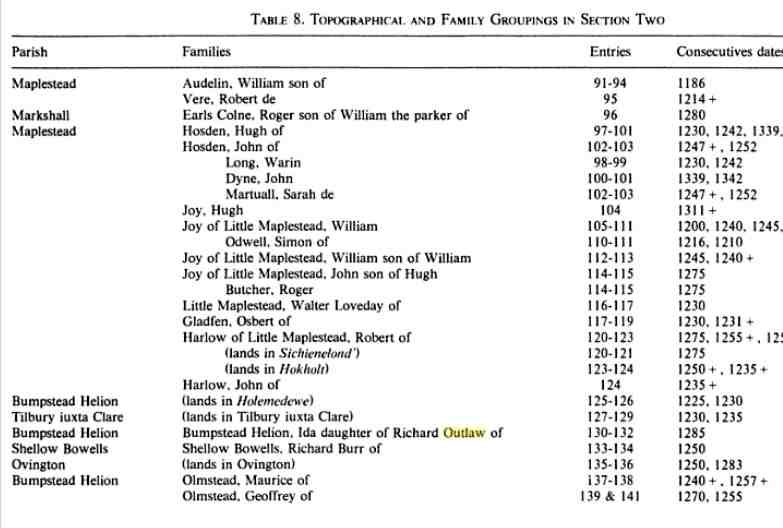
Page 350
Ida daughter of Richard Outlaw of , 59
Page 359
Roger [ son of Richard ] Outlaw ( of Bumpstead Helion ), Ida daughter of Richard, see Bumpstead Helion.
( Notice the Earl of Oxford "De Vere" connection ! )
| - - - - -
Helions Bumpstead
- is a small village in Essex
located near Haverhill
and the Essex/Suffolk/Cambridgeshire
borders.
...
Helions Bumpstead was well known to historians in the time of Edward
the Confessor, before the Norman
Conquest. Then the whole area of which we know now as Steeple
and Helions Bumpstead, was called collectively Bumsteda, or variations of this
earliest way of spelling. As more people drifted into this area, two distinct
centres developed, with the Helions part taking on the title of Bumpstead Magna
(Great) and the Steeple district Bumpstead Parva (Little).
...
The village history seems to take off from William the Conqueror and the
compiling of the Domesday Book. The new King of England rewarded an officer
of his invading army by granting him the Manor of Bumstead. The officer by the
name of Tihell, came from a village in France named Hellean,
in the Morhihan district of Brittany. It was here in England that he built a
Manor House on a hill facing due east, and then on a small mound not half a mile
away, he built his Church.
Ok - What was the requirement of Roger Outlawe's backgound in 1300?
Whoever wished to be received into the brotherhood, was required to prove his nobility for four descents, and that by his mother's as well as his father's side; to be of legitimate birth, (an exception being made only in favour of the natural sons of kings and princes); to be not less than twenty years old; and, in moral character, blameless
1285 - Hospitaller Charter of Ida daughter of the late Richard Utlaw of the five acres of land and half an acre of meadow, with appurtenances. - Roger [ son of Richard ] Outlaw ( of Bumpstead Helion ), Ida daughter of Richard
Here it says he had to be a knight or son of a knight or legitimate of a noble family (one generation) - by 1270's all higher offices were reserved to the Knight-brothers - So who was Roger Outlawe's father?
The Knights Hospitaller - Helen Nicholson
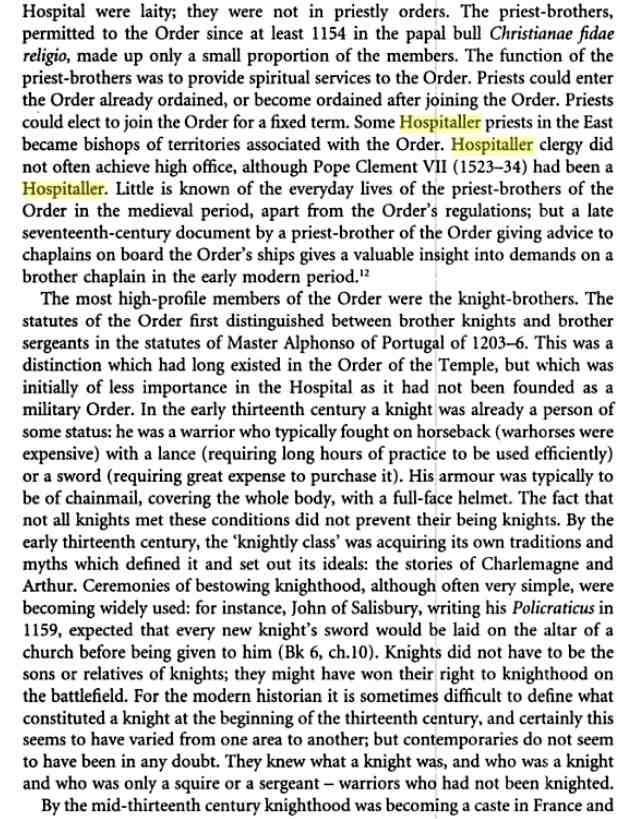
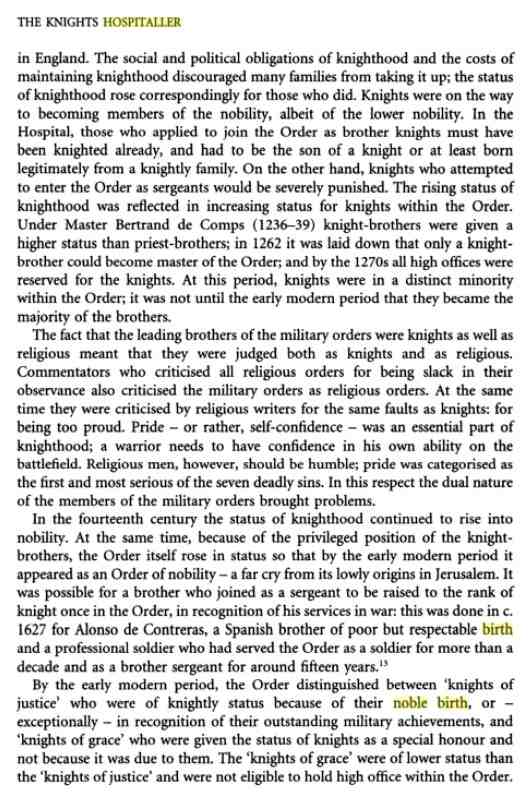
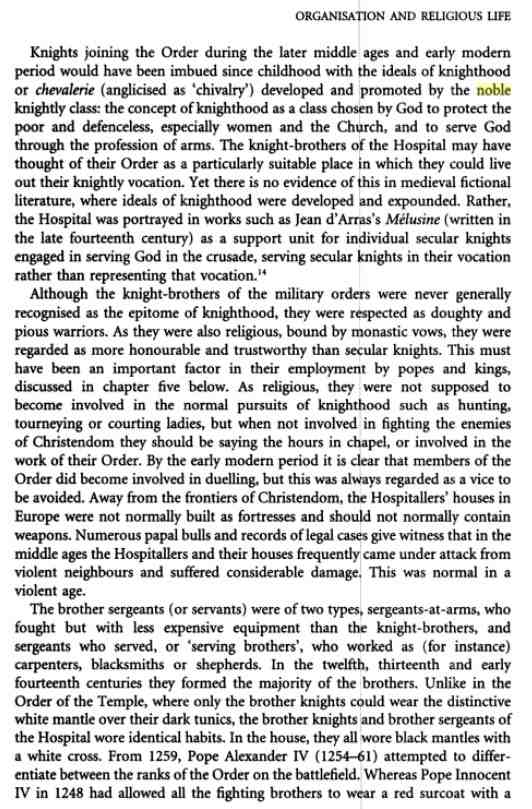
Templecombe Preceptory Somerset:
Templer Panel Circa 1280:
The history and antiquities of the round church at Little Maplestead
The cells, or subordinate foundations to the great house of the Hospitallers were properly called Commanderies ; but,
like those
of the Templars, they were almost as frequently called Preceptories.
A few of these had the appearance of being separate corporations, so much so as to have a common seal; but the
greater part were no more than farms, or granges.
" It is possible that some few Preceptories existed, which may not be included in the present enumeration.
Preceptories of the Hospitallers.
1. Ansty, in the county of Wilts.
2. Aslakeby, in the county of Lincoln.
3. South Badeisley, in Hampshire.
4. Balshall, in Warwickshire.
5. Barrow, in Cheshire.
6. Batisford, in Suffolk.
7. Beverley, in Yorkshire.
8. Brimpton, in Berkshire.
9. Bruern, or Temple Bruer, in Lincolnshire.
10. Carbroke, in Norfolk.
11. Chippenham, in Cambridgeshire.
12. Temple Comb, in Somersetshire.
13. Temple Cowley, or Sandford, in Oxfordshire.
14. Temple Cressing, in Essex.
15. Dalby, in Leicestershire.
16. Dingley, in Northamptonshire.
17. Dynmore, in Herefordshire.
18. Temple Dynnesley, in Hertfordshire.
19. Egle, or Aquilse Ballivatus, in Lincolnshire.
20. Gilsingham, in Suffolk.
21. Godesfield, in Hampshire.
22. Gosford, in the parish of Kidlington, in Oxfordshire.
23. Halston, or Hawston, in Norfolk.
24. Hampton, in Middlesex.
25. Hether, in Leicestershire.
26. Hogshaw, in Buckinghamshire.
27. Maltby, near Lowth, in Lincolnshire.
28. Little Maplestead, in Essex.
29. Mayne, or Fryer-Mayne, in Dorsetshire.
30. Melchburn, in Bedfordshire.
31. Mere, in Lincolnshire.
32. Mount St. John, in the deanery of Bulmer, and archdeaconry of Cleveland, in Yorkshire.
33. Newland, in the deanery of Pontefract, in Yorkshire.
34. Little, or West Peccham, in Kent.
35. Pooling, in Sussex.
36. Queinington, in Gloucestershire.
37. Ribstane, in the West Riding of Yorkshire.
38. Temple Rockley, in Wiltshire.
39. Rotheley, in Leicestershire.
40. Shengay, in Cambridgeshire.
41. Skirbeke, in Lincolnshire.
42. Slebach, in Pembrokeshire.
43. Standon, in Hertfordshire.
44. Sutton at Hone, in Kent.
45. Swinford, in Leicestershire.
46. Swingfield, in Kent.
47. Trebigh, or Turbigh, in Cornwall.
48. Waingrif, near Rippele, in Derbyshire.
49. Warwick, in Warwickshire.
50. Great Wilburgham, in Cambridgeshire.
51. Wileketone, in Lincolnshire.
52. Witham, or South Wytham, in Lincolnshire.
53. Yeveley, alias Stede, in Derbyshire.
Preceptory of the Knights Hospitallers of the Order of St John of Jerusalem - Sutton-At-Hone - National Trust
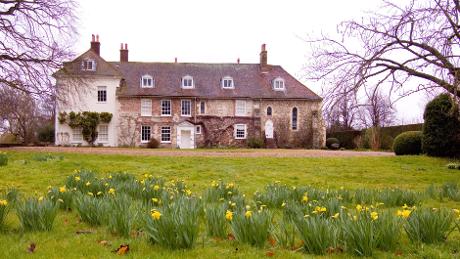
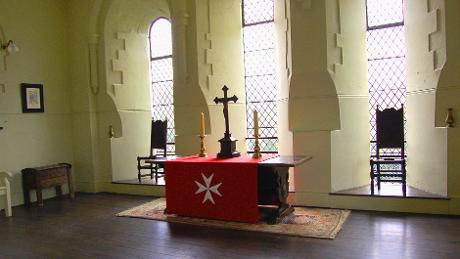
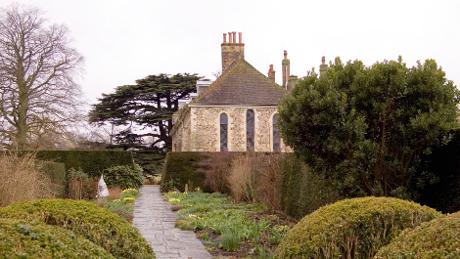
Set in the Darenth Valley, the rare surviving chapel is the only remaining structure of the Preceptory of the Knights Hospitallers of the Order of St John of Jerusalem formed in 1113.
The chapel is adjacent to a now privately occupied and much altered house, dating from the 16th century. The preceptory is thought to have gone out of use by 1338, after which time it was used as a residence.
Among its later occupants were Abraham Hill, a founder of the Royal Society, and the historian Edward Hasted. The chapel and tranquil gardens are surrounded by a moat, one arm of which is the River Darenth.
| - - -
Sutton-at-Hone - is a village 2 miles (3 km) south of Dartford in Kent, England. It is part of the Dartford local government district and the civil parish of Sutton-at-Hone and Hawley.
Sutton-at-Hone has a long history. A Commandery of the Knights Hospitaller of the Order of Saint John of Jerusalem was established in Sutton-at-Hone in 1199, and is now the National Trust property St. John's Jerusalem. The part of the St. John Jerusalem property open to the public (on Wednesday afternoons, April - October) includes the 13th century chapel of the Knights Hospitaller and a garden moated by the River Darent.
The church of St. John the Baptist was in existence by 1077. It was rebuilt in the fourteenth century, and that church had to have substantial re-building work following a fire in 1615, reputedly caused by a person firing a gun at a bird that was in the church
Sutton at Hone, in Kent is interesting since it is very close to Darenth St. Margaret Helles
Gravesend
, Kent - Darenth - The antiquity of the place is all but swamped
now but the village was once given by King Athelstan (AD 925-940) to Duke
Eadulf and later passed into the possession of Christ Church at
Canterbury, to become one of the manors of the Archbishop of Canterbury.
Archbishop Hubert Walter exchanged the church and manor of Darenth for the
manor of Lambeth in 1195.
Two of the smaller Darenth
manors, St Margaret Helle (or Helles) and Clequdon have since become lost.
The chapel of St Margaret Helle was mentioned in the Textus Roffenses,
where it was assessed at sixpence a year payable to Rochester Cathedral. In 1522
Archbishop Warham ruled that although it could baptise and bury local people,
marriages could only be solemnised at the parish church, which was some distance
away.
Nothing of the chapel remains today but the parish church continues to
be dedicated to St Margaret, also. It dates from the l0th century and its
fabric contains remnants of a nearby Roman villa on the banks of the River
Darent which was excavated in 1894/95. One of the features of the church is the
great sculpted Romanesque font which dates from about 1140. The church, which
stands on Darenth Hill, is said to be the third oldest in Kent, having been
built in about AD 940 although, of course, added to after that. It was
largely destroyed by fire in 1710 and restored.
So the bit that goes "De
Helia ": Refers
to "the Darenth manor, St Margaret Helle (or Helles)"
De Helia Vtlagh' xvd. ob.
Darenth kent england [ Notice that "forest" BEAN and Sutton-At-Hone are very close to Darenth (St. Margaret Helles) along with Gravesend]
This is interesting was a man named "Utlag" a Dane that declared himself King?
5 Ut-lagcde of Engla-land. (Ibid.) I,eg signifies countrv, state, statute, law. — from the verb lagen, to place, to establish. Utlage. out-law, signifies a mau banished or outlawed.
The Danish soldiers cantoned in the towns, or stationed in ships at the mouth of the rivers, made choice of his son
Knut, or Canute, to succeed the Danish king. That prince was then engaged on a mission to the country near the 11 umber, to deposit there the contributions and the hostages of the southern English. The latter, encouraged by his absence, deliberated on sending a messenger to the exile then in Normandy, to tell him, in the name of the Anglo-Saxon people, that they would take him again for king, if he would promise to govern better for the future.'
In answer to this message, Ethelred sent over his son Edward, charging him to salute in his name the whole English nation,- and to make adjuration in his name, publicly, that the king would in future fulfil all the duties of his high office faithfully,3 amend whatever was displeasing to the people, and consign to oblivion all which the people had done or said against himself. The amity thus sworn to
between the nation and king was confirmed on either side by pledges mutually given (1015).4
The assembly of the Witteuanghemote pronounced against any Dane who should take the title of king of England a perpetual sentence of
outlawry.5
Ethelred reassumed the regal insignia; but it is not exactly known over what extent of territory he reigned; for the Danish garrisons, though driven from some towns, kept possession of many others,
and even the city of London remained in power. Perhaps the great way called
Waethlingstreet had once more become the line of demarcation betwixt the free provinces and those remaining subject to the foreign or Danish rule.
King Knut, the son of Sweyn, being dissatisfied with the portion which the Anglo-Saxons compelled him to accept, returned from the north of England, and, having landed near Sandwich,
he caused the hostages delivered to his father to be mutilated' and put to the torture, through anger at his own disappointment. This example of useless cruelty was the signal for a new war, which Ethelred, faithful to his late oath, sustained courageously amid various successes and reverses.
At his death the English chose for their king, not one of his legitimate children, who were residing in Normandy, but a natural son, Edmund, surnamed Ironside, who had. given some remarkable proofs of valour and skill (1016). By his energetic conduct, Edmund retrieved the fortunes of the English people; he retook London from the Danes, and fought five great battles against them.7
Sweyn Forkbeard -
(Old Norse:
Sveinn Tjúguskegg; d. 3 February 1014) was king
of Denmark and England,
as well as parts of Norway.
His name appears as Swegen in the Anglo-Saxon
Chronicle.[1]
He was the son of King Harald
Bluetooth of Denmark. He was the father of Cnut
the Great.
...
After a long effort at conquest, and shortly before his death, in 1013 he became
the first of the Danish
Kings of England.
Sweyn's father, Harald
Bluetooth, was the first of the Scandinavian
kings to accept Christianity
officially, in the early or mid-960s. According to Adam
of Bremen, an 11th-century historian, Harald's son Sweyn was baptised Otto,
in tribute to the German
king Otto
I,[5]
who was the first Holy
Roman Emperor. Forkbeard is never known to have officially made use of this
Christian name.
...
According to the chronicles of John
of Wallingford, Sweyn was involved in raids against England
during 1002–1005, 1006–1007, and 1009–1012, to revenge the St.
Brice's Day massacre of England's Danish inhabitants in November 1002.
Historians have considered the massacre as similar to a large-scale ethnic
cleansing of the Danes in England orchestrated by Æthelred
the Unready. Sweyn was believed to have had a personal interest in the
atrocities due to his sister Gunhilde
being amongst the victims
...
King Æthelred sent his sons Edward and Alfred to Normandy, and retreated to
the Isle of Wight, and then followed them into exile.[14]
On Christmas Day 1013 Sweyn was declared king of England.
Based in Gainsborough, Lincolnshire, Sweyn began to organise his vast new kingdom, but he died there on 3 February 1014, having ruled England unopposed for only five weeks. His embalmed body was returned to Denmark, to be buried in the church he built in Roskilde.[15] He was succeeded as King of Denmark by his elder son, Harald II, but the Danish fleet proclaimed his younger son Cnut king. In England, the councillors had sent for Æthelred, who upon his return from exile in Normandy in the spring of 1014 managed to drive Cnut out of England. But Cnut returned and became King of England in 1016, while also ruling Denmark, Norway, parts of Sweden, Pomerania, and Schleswig.
His son Cnut and grandsons Harold Harefoot and Harthacnut ruled England for 26 years. After Harthacnut's death, the English throne reverted to the House of Wessex. Sweyn's descendants through his daughter Estrid continue to rule Denmark to this day. One of his descendants, Margaret of Denmark, married James III of Scotland, introducing Sweyn's bloodline into the Scottish Royal blood line. After James VI of Scotland inherited the English throne in 1603, Sweyn's ancestry was introduced into the English royal bloodline as well.
A Descriptive Catalogue of Ancient Deeds in the Public Record Office - Vol 4
Camb.
A, 10029, Feofi'ment by Maud late the wife of William le Mareys of Berton and Margaret daughter of the said William to Gamelyn de Cottyngwyth of Berton of three selions lying together in
Madwefeld of Berton at ‘ le Cros ' next land which Geoffrey le Lorymer held in bondage of Sir Bartholomew de Burwahs, abutting on
Robert Outelawe's land. Sunday after St. Mark, 20 Edward III.
1347 - Robert Outelawe's land in Barton Cambridge - Madwefeld of Berton at ‘ le Cros '
Selion - is a mediaeval open strip of land or small field used for growing crops, usually owned by or rented to peasants. A selion of land was typically one furlong (660 ft) long and one chain (66 ft) wide. However, exact measurements could vary depending on geography of the land. The area of one furlong by one chain is one acre. Monasteries or similar institutions were often bequeathed selions and then derived an income from them by letting
The Parish Church of St Peter - History - These parishes have chosen to identify themselves as the 'Mare Way Group' (as in Mary's Way). This name recognises the Medieval Pilgrims' Way between Canterbury, St Albans, Ely and Walsingham in North Norfolk, which links four of our villages and from which the fifth can be overseen when travelling on it. This ancient trackway starts on Barrington Hill, near the site of our Easter dawn gathering, close to the Chapel of Our Lady of the White Hill. The route then follows the ridge until the Bourn Brook, marking our border with Kingston and Toft. When walking along it, the cobwebs are blown away and you can see across Hertfordshire and the Fens for great distances. The trackway and the naming of our benefice give a sense of travel by a pilgrim people.
Never added Capt. John and brother Edward Outlaw to the timeline -
Notice that our founders were born into the first English Civil War - which maybe a reason for the lack of records:
1626 - Robert Outlaw
- born 1626 - died 1680 - Ringland Parish Norfolk
1640 ~ Captain John Outlaw
- Birth abt 1640 - Possible Father Robert Outlaw born abt 1626 grave Ringland
parish 1680 died abt 1697 Boucherville, Montreal Quebec Canada
1652 ~Edward Outlaw - Birth Abt 1652 - Possible Father Robert Outlaw born abt 1626 grave Ringland parish 1680 died 1712
New find - John Outlawe - 1395-6 Lincolnshire
1395 - John Outlawe juror Sleaford Kesteven Lincolnshire - Kesteven - Sleaford
1396 - Richard of Greteham of Marton 'netmaker indicted for stealing three sheep of John Outlawe t he day after the feast of St. Michaels - Marton, Lincolnshire
Some sessions of Peace in Lincolnshire 1381-1396
Outlawe, Utlawe, John, juror, 14, 22 (85)
KESTEUEN'
Inquicissio capta apud Sleford coram predictis iusticiarijs die Lune proxima post festum epiphanie domini anno supradicto
[11 January 1395] per sacramentum Thome Bate de Digby lohannis Goldyng de Kirkeby lohannis Outlawe lohannis Lord
Willilmi Wright' de Scoupwyk Roberti Rydale Willelmi Richardson' de Uygby,
lohannis Hyde de Thorp' Roberti de Bolyngton' Willemi Steregarth' Thome Kidenot et lohannis Watson' de Tymberlond iuratorum.
Inquicissio taken at Sleaford before the justices on Monday after the feast of the Epiphany in the said year [11 January 1395],
by the oath of Thomas Bate, John Digby Goldyng of Kirkby, John
Outlawe, Lord William Wright of Scoupwyk, Robert Rydale, William Richardson
of Uygby, John Hyde of Thorpe, Robert Bolyngton, William Steregarth, Thomas Kidenot and John Watson of Tymberlond
jurors.
1395 - John
Outlawe juror Sleaford Kesteven
Lincolnshire - Kesteven
- Sleaford
85. Ricardus de Greteham de Marton' netmaker indictatus est per dictam inquisicionem de eo quod ipse die Lime proxima post festum sancti MicheKs anno regni regis Ricardi secundi xvij° apud
Marton' tres bidentes de loharme Vtlawe felonice furatus fuit.
Richard of Greteham of Marton 'netmaker indicted by the inquiry because the day after the feast of St.
Michaels seventeenth year of the reign of Richard II at Marton' three sheep of
John Outlawe feloniously stole.
1396
1396 - Richard of Greteham of Marton 'netmaker indicted for stealing three sheep of John Outlawe the day after the feast of St. Michaels - Marton, Lincolnshire
Kesteven ... The
Parts of Kesteven are a traditional subdivision of Lincolnshire, England
It includes the towns and village of:
Bourne
Bracebridge
Grantham
Market Deeping
Ruskington a village
Sleaford
Stamford
Sleaford - is a town in the North Kesteven district of Lincolnshire, England.
William the Conqueror gave the manor of 'Eslaforde' to Remigius de Fécamp, the first Bishop of Lincoln, in around 1086.
About 1130, Bishop Alexander of Lincoln built a castle just southwest of the town. The footings and moat can still be seen, in what is now the Castle Fields. This was the period in which the town moved westwards. The castle was demolished in the Elizabethan era, not later than 1600.
...
The parish church of St. Denys forms the eastern side of the town's market place. The building, which has the oldest stone broach spire in England,[16] mostly dates from 1180 although sections were rebuilt following an electrical storm in 1884
Marton, Lincolnshire - is a village and civil parish in the West Lindsey district of Lincolnshire,
In the centre of the village stands the church of Saint Margaret of Antioch. The building is essentially of the Norman Conquest period, built using a mixture of Anglo-Saxon and Norman styles
William De Baliol (1251 - 1313)
| b. abt 1251 at Bernard Castle, Gainford, Durham, England |
| d. abt 1313 aged 62 |
| Near Relatives of William De Baliol (1251 - 1313) | ||||||
| Relationship | Person | Born | Birth Place | Died | Death Place | Age |
| Father | John de Baliol I | abt 1212 | Barnard Castle, Gainford, Durham, England | 12 Oct 1269 | Bernard Castle, Gainford, Durham, England | 57 |
| Mother | Dervorgilla de Galloway | abt 1218 | <, Galloway, Wigtown, Scotland> | abt 1289 | Kempston, England | 71 |
So here we have a record of Thomas Utlaghe in association with William Baliol a son of Baron John De Baliol I (father of the Norman King of Scotland) William would have been a brother of John Baliol the contender for the Scotish Throne - Here we have a crusade connection and a Hitchin connection ...
1270 - Eighth
Crusade - 20 August Edward sailed from Dover
for France, brought with him around 225 knights and all together
1000 men - April
1270 Parliament agreed an unprecedented levy of one-twentieth of every
citizen's goods and possessions to finance Edward's Crusade to the Holy Lands.
1270 - Hugo
le Utlagh - Thomas le Utlagh - Bodeham - Close Rolls, May 1270 - Henry III -
Hugh le Utlagh is come before the king and asked for the land of
Thomas le Utlagh to the same Thomas in Bodeham released on pledges,
etc.
| - - - - - -
John I de Balliol - (died 25 October 1268) was a leading figure of Scottish and Anglo-Norman life of his time. Balliol College, in Oxford, is named after him.
He was born before 1208 to Hugh de Balliol, Lord of Balliol and of Barnard Castle and Gainford (c. 1177–February 2, 1229) and Cecily de Fontaines, daughter of Aleure, lord of Fontaines and Longpré-les-Corps-Saints.
In 1223, Lord John married Dervorguilla of Galloway, the daughter of Alan, Lord of Galloway and Margaret of Huntingdon. By the mid-thirteenth century, he and his wife had become very wealthy, principally as a result of inheritances from Dervorguilla's family. This wealth allowed Balliol to play a prominent public role, and, on Henry III's instruction, he served as joint protector of the young king of Scots, Alexander III. He was one of Henry III's leading counsellors between 1258 and 1265.[1] and was appointed Sheriff of Nottinghamshire and Derbyshire from 1261 to 1262. He was captured at the Battle of Lewes in 1264 but escaped and rejoined King Henry. In 1265 Thomas de Musgrave owed him a debt of 123 marks. About 1266 Baldwin Wake owed him a debt of 100 marks and more.
| - - - -
John Balliol - (Norman French: Johan de Bailliol, Middle Scots: Jhon Ballioun;[1][2] c. 1249 – 25 November 1314), known as Toom Tabard (Scots for "empty coat"), was King of Scots from 1292 to 1296
Little of Balliol's early life is known. He was born between 1248 and 1250 at an unknown location; possibilities include Galloway, Picardy and Barnard Castle, County Durham.[3] He was the son of John, 5th Baron Balliol, Lord of Barnard Castle, and his wife Dervorguilla of Galloway, daughter of Alan, Lord of Galloway and granddaughter of David, Earl of Huntingdon.[4] From his mother he inherited significant lands in Galloway and claim to Lordship over the Gallovidians, as well as various English and Scottish estates of the Huntingdon inheritance; from his father he inherited large estates in England and France, such as Hitchin, in Hertfordshire.
130805-archaeology-israel-jerusalem-crusader-middle-east-excavation
Part of a gigantic, thousand-year-old structure that served as the largest hospital in the Middle East during the Crusader period will soon be open to the public, following a 13-year excavation, the Israel Antiquities Authority announced Monday.
Located in the Christian Quarter of the Old City of Jerusalem and owned by the Muslim Waqf (an Islamic endowment of property held in trust for charitable or religious purposes), the 11th-century structure spans more than 150,000 square feet and is characterized by massive pillars and ribbed vaults, with ceilings as high as 20 feet.
The Grand Bazaar Company of East Jerusalem initiated the excavation and research in cooperation with the Antiquities Authority. It plans to turn the structure into a restaurant and visitor center, expected to open to the public in the next year.
On Monday, the Antiquities Authority unveiled a main hall, which is similar in appearance to the Knights' Hall in Acre, in northern Israel, and is estimated to constitute only a small part of what functioned as a massive hospital.
| - - - - - -
530 - The Order of Saint Lazarus established leper hospitals with the first being in Jerusalem in the year 530 - Burton Lazars
1095-99 - First
Crusade
1098 - Edgar
The Outlaw Ætheling - given a fleet by Emperor
Alexius I Byzantine Emperor to assist in the First Crusade
1099 - Soldiers
of the First Crusade successfully scale the walls of Jerusalem and take
the Holy city - July15 1099
1113 - Hospitaller's
in Jerusalem receive papal approval of independence
1115 - Official
recognition of the Hospital of Saint Lazarus came by a Bull of Pope
Pascal II in 1115
1116 - The
Order of Hospitallers was founded in the 11th century and recognized by Pope
Paschal II in 1116.
I really need a separate Hospitaller history page - I need to consolidate with Outlawe Research Journal - Page 8 and Laurence Outlaw (Utlator) - Lynn - Mary Magdalen,,,,
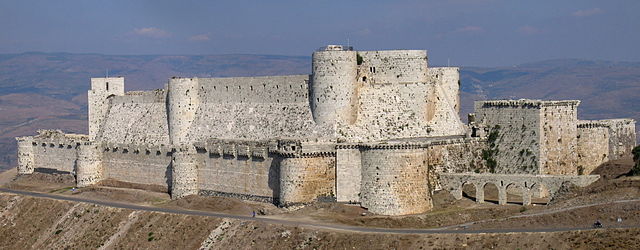
Krak des Chevaliers - also Crac des Chevaliers, is a Crusader castle in Syria and one of the most important preserved medieval castles in the world. The site was first inhabited in the 11th century by a settlement of Kurds; as a result it was known as Hisn al Akrad, meaning the "Castle of the Kurds". In 1142 it was given by Raymond II, Count of Tripoli, to the Knights Hospitaller. It remained in their possession until it fell in 1271. It became known as Crac de l'Ospital; the name Krak des Chevaliers was coined in the 19th century.
The Hospitallers began rebuilding the castle in the 1140s and were finished by 1170 when an earthquake damaged the castle. The order controlled a number of castles along the border of the County of Tripoli, a state founded after the First Crusade. Krak des Chevaliers was amongst the most important and acted as a centre of administration as well as a military base. After a second phase of building was undertaken in the 13th century, Krak des Chevaliers became a concentric castle. This phase created the outer wall and gave the castle its current appearance. The first half of the century has been described as Krak des Chevaliers' "golden age". At its peak, Krak des Chevaliers housed a garrison of around 2,000. Such a large garrison allowed the Hospitallers to extract tribute from a wide area. From the 1250s the fortunes of the Knights Hospitaller took a turn for the worse and in 1271 Krak des Chevaliers was captured by the Mamluk Sultan Baibars after a siege lasting 36 days, and then purportedly only by way of a forged letter purportedly from the Hospitallers' Grand Master that caused the Knights to surrender.
...
In the 1250s, the fortunes of the Hospitallers at Krak des Chevaliers took a turn for the worse. An army estimated to number 10,000 men ravaged the country around the castle in 1252. After this, it seems the order's finances were badly affected. In 1268 Master Hugh Revel complained that the area, which had previously been home to around 10,000 people, was deserted and the order's property in the Kingdom of Jerusalem was producing little income; he also noted that by this point there were only 300 of the order's brothers left in the east. On the Muslim side, a new Sultan, Baibars, seized power in 1260 and united Egypt and Syria. One of the effects was that Muslim settlements which had previously paid tribute to the Hospitallers at Krak des Chevaliers were no longer intimidated into doing so
| - - - - - -
Muristan - is a complex of streets and shops in the Christian Quarter of the Old City of Jerusalem. The site was the location of the first hospital of the Knights Hospitaller.
The area just south of the Church of the Holy Sepulchre has a long tradition dating to the days of Yehuda haMaccabi (2nd century BC) based on incidents recorded in the Second Book of Maccabees.[1] According to the legend, King Antiochus V proceeded to Jerusalem to punish the High Priest for plundering David's Tomb. While on Golgotha, the king was directed in a divine vision to pardon the High Priest, and to build a hospital for the care of the sick and poor on that spot. In 1496, William Caoursin, Vice-Chancellor of the Hospitallers, wrote that Judas Maccabaeus and John Hyrcanus founded the hospital on that spot.
...
The earliest historical mention of the location Muristan is in 600 AD, when a certain Abbot Probus was commissioned by Pope Gregory the Great to build a hospital in Jerusalem to treat and care for Christian pilgrims to the Holy Land. This hospice was most likely destroyed about fourteen years later when Jerusalem fell to the Persian army and the Christian inhabitants were slaughtered, and their churches and monasteries destroyed (see Revolt against Heraclius). The building was probably restored after Jerusalem fell again under Roman dominion in 629. Arab rule after 637 allowed freedom of worship, and the restored hospice was probably allowed to continue serving its original purpose. Bernard the Monk, who wrote an account of his visit to Jerusalem in 870, mentions a Benedictine hospital close to the Church of the Holy Sepulchre. In 993, Hugh Marquis of Tuscany and his wife endowed the hospital with considerable property in Italy
...
In 800, Charlemagne, Emperor of the Holy Roman Empire, enlarged the hostel and added a library to it. About 200 years later, in 1005, Caliph Al Hakim destroyed the hostel and a large number of other buildings in Jerusalem
...
In August 1098, the Turks were ousted by the Egyptian vizier, Al Afdal.[7] Towards the end of the Egyptian occupation (July 1099), the Hospital for Women was being managed by a noble Roman Lady, named Agnes, while the Hospital for Men was under the direction of a monk known as Brother Gerard
...
Excavations of the Muristan were conducted around the start of the 20th century, and showed that the Hospitaller complex occupied an approximately square area measuring 160 yards (east-west) and 143 yards (north-south). In the early decades of the twentieth century little was left of the original buildings. The remains included the Church of Mar Hanna, a series of arches on David Street, and the remains of the north door of the Hospitaller's church of St. Mary Latina, which were incorporated into the modern Church of the Redeemer. What remains of the hospital today is a modern memorial situated in a small recess barred from the street with an iron gate and an enclosed yard
| - - - - - -
Knights Hospitaller - The Hospitallers probably arose as a group of individuals associated with an Amalfitan hospital in the Muristan district of Jerusalem, which was dedicated to St John the Baptist and founded around 1023 by Blessed Gerard Thom to provide care for poor, sick or injured pilgrims to the Holy Land. (Some scholars, however, consider that the Amalfitan order and Amalfitan hospital were different from Gerard's order and its hospital.[1]) After the Western Christian conquest of Jerusalem in 1099 during the First Crusade, the organisation became a religious and military order under its own Papal charter, and it was charged with the care and defence of the Holy Land. Following the conquest of the Holy Land by Islamic forces, the Order operated from Rhodes, over which it was sovereign, and later from Malta where it administered a vassal state under the Spanish viceroy of Sicily.
The monastic hospitaller order was founded following the First Crusade by the Blessed Gerard, whose role as founder was confirmed by a Papal bull of Pope Paschal II in 1113.[4] Gerard acquired territory and revenues for his order throughout the Kingdom of Jerusalem and beyond. Under his successor, Raymond du Puy de Provence, the original hospice was expanded to an infirmary[1] near the Church of the Holy Sepulchre in Jerusalem. Initially the group cared for pilgrims in Jerusalem, but the order soon extended to providing pilgrims with an armed escort, which soon grew into a substantial force. Thus the Order of St. John imperceptibly became military without losing its eleemosynary character.[1] The Hospitallers and the Knights Templar became the most formidable military orders in the Holy Land. Frederick Barbarossa, the Holy Roman Emperor, pledged his protection to the Knights of St. John in a charter of privileges granted in 1185.
The statutes of Roger de Moulins (1187) deal only with the service of the sick; the first mention of military service is in the statutes of the ninth grand master, Alfonso of Portugal (about 1200). In the latter a marked distinction is made between secular knights, externs to the order, who served only for a time, and the professed knights, attached to the order by a perpetual vow, and who alone enjoyed the same spiritual privileges as the other religious. The order numbered three distinct classes of membership: the military brothers, the brothers infirmarians, and the brothers chaplains, to whom was entrusted the divine service.[1]
The order came to distinguish itself in battle with the Muslims, its soldiers wearing a black surcoat with a white cross. In 1248 Pope Innocent IV (1243–54), approved a standard military dress for the Hospitallers to be worn in battle. Instead of a closed cape over their armour (which restricted their movements) they should wear a red surcoat with a white cross emblazoned on it.[5]
Many of the more substantial Christian fortifications in the Holy Land were built by the Templars and the Hospitallers. At the height of the Kingdom of Jerusalem, the Hospitallers held seven great forts and 140 other estates in the area. The two largest of these, their bases of power in the Kingdom and in the Principality of Antioch, were the Krak des Chevaliers and Margat in Syria.[4] The property of the Order was divided into priories, subdivided into bailiwicks, which in turn were divided into commandries.
As early as the late 12th century the order had begun to achieve recognition in the Kingdom of England and Duchy of Normandy. As a result, buildings such as St John's Jerusalem in England were built on land donated to the order by local nobility
Frederick I, Holy Roman Emperor - (1122 – 10 June 1190) was a German Holy Roman Emperor.
...
Frederick vowed to take up the cross at the Diet of Mainz in 1188.[49] Frederick embarked on the Third Crusade (1189), a massive expedition in conjunction with the French, led by king Philip Augustus, and the English, under Richard the Lionheart. He organized a grand army of 100,000 men (including 20,000 knights) and set out on the overland route to the Holy Land.[67] However, some historians believe that this is an exaggeration and that the true figure might be closer to 15,000 men, including 3,000 knights.[68]
The Crusaders passed through Hungary, Serbia and Bulgaria and then entered Byzantine territory, arriving at Constantinople in the autumn of 1189. Matters were complicated by a secret alliance between the Emperor of Constantinople and Saladin, warning of which was supplied by a note from Sibylla, ex-Queen of Jerusalem.[2] When they were in Hungary, Barbarossa personally asked the Hungarian Prince Géza, brother of the king, Béla III of Hungary, to join the Crusade. The king agreed, and a Hungarian army of 2,000 men led by Géza escorted the German emperor's forces. The armies coming from western Europe pushed on through Anatolia (where they were victorious in taking Aksehir and defeating the Turks in the Battle of Iconium), and entered Cilician Armenia. The approach of the immense German army greatly concerned Saladin and the other Muslim leaders, who began to rally troops of their own to confront Barbarossa's forces.[3]
On 10 June 1190, Emperor Frederick drowned in the Saleph river.[69] He had decided to walk his horse through the river instead of crossing the bridge that had been too crowded with troops. The current was too strong for the horse to handle, and his suit armour was too heavy for him to swim in: both were swept away and drowned. Some historians believe he may have had a heart attack that complicated matters. Some of Frederick's men put him in a barrel of vinegar to preserve his body.
Frederick's death plunged his army into chaos. Leaderless, panicking, and attacked on all sides by Turks, many Germans deserted, were killed, or committed suicide. Only 5,000 soldiers, a small fraction of the original force, arrived in Acre. Barbarossa's son, Frederick VI of Swabia, carried on with the remnants of the German army, along with the Hungarian army under the command of Prince Géza, with the aim of burying the emperor in Jerusalem, but efforts to conserve his body in vinegar failed. Hence, his flesh was interred in the Church of St Peter in Antioch, his bones in the cathedral of Tyre, and his heart and inner organs in Tarsus.[3]
The unexpected demise of Frederick left the Crusader army under the command of the rivals Philip II of France and Richard I of England, who had traveled to Palestine separately by sea, and ultimately led to its dissolution. Richard continued to the East where he defeated Saladin in many battles, winning significant territories along the shores of Palestine, but ultimately failed to win the war before he was forced to return to England (see Treaty of Ramla). He returned home after he signed the treaty under the terms of the agreement that Jerusalem would remain under Muslim control. However, the city would be open to Christian pilgrimages. Also, the treaty reduced the Latin Kingdom to a geopolitical coastal strip that extended from Tyre to Jaffa
Since I got new photos of Ralph Outlawe's Slab in Bintree , Bintree - Bintry - Ralph Outlaw
It's got me looking at the possible genealogy of Edward and John Outlawe again. Maybe it's just wishful thinking but maybe something new is around, One thing is the date of Ralph Outlawe and Eliz. Kempe marriage , which now seems to be earlier than what I had known, so that makes more sense since the first son Thomas (1615?) had to be born before Rev. Ralph Outlawe in 1620 - So the marriage had to be at least before 1615,,,
| - - - - - -
Re Outlaw geneology website - Outlaw - Family History & Genealogy Message Board - Ancestry.com
...
Robert Outlaw of 1625 had 4 sons and 2 daughters see below
Sarah Outlaw dob estimated
Captain John Outlaw
Elizabeth Outlaw
Ralph Outlaw [ just what we need
another Ralph ! ]
Edward Outlaw 1650
Thomas Outlaw
[ This seems to be correct or maybe
wishful thinking - the dates don't make sense - getting born in 1595
married at 15 ? and you have your first child, Thomas ? More likely they were
married 1614 - the marriage would have shown up in the 1613 visitation records.
I don't think it did. It does make sense that as the third son is mentioned in
the will of Sir Robert Kempe and that Robert was named after his sisters brother
and lofty relative - so is this clear as mud? ]
Ralph Outlaw 1595, Ralph Outlaw married Elizabeth Kempe 1595 they had 7 children
[ Seven ??? No the last three must be
children of Robert Outlaw
Thomas Outlaw 1615,
Rev. Ralph Outlaw 1620, [ now
this is correct Ralph is the second son ! Thomas is the first son ]
Robert Outlaw 1625,
Mary Outlaw 1635,
Edward Outlaw 1658, Charles Outlaw 1657, Elizabeth Outlaw, [
these must be Robert Outlaw's children ]
The question is who was Robert
Outlawe's wife and where did he live and where are the records?
Full text of An introduction to heraldry
46 Introduction to Heraldry.
BLAZONING OF PLATE XIV.
1 . Argent, a saltire gules, between four wolves' heads couped proper ; name, Outlawe.
A short and easy introduction to heraldry, in two parts ..
PART I. HERALDRY. 59
BLAZONING OF PLATE D.
N. 1. Argent, a saltire gules, between four wolves' heads couped proper, name, Outlawe.
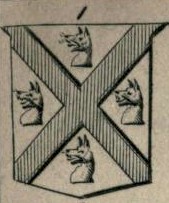
A = Argent (Silver or White)
G = Gules (Red)
ABBREVIATED BLAZONS OF PLATE E.
N. 1. A, a saltire G, between four wolves' heads couped Ppr. name, Outlawe.
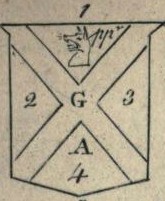
---- >>> Back to Outlawe Research Journal - Page 11